Human Anatomy - Chapter 3
5.0(1)
Card Sorting
1/70
Earn XP
Description and Tags
Study Analytics
Name | Mastery | Learn | Test | Matching | Spaced |
|---|
No study sessions yet.
71 Terms
1
New cards
How many cells does the average adult have?
100 trillion
2
New cards
What is a generalized view of a cell?
a composite of many different cells
3
New cards
What are the 3 parts of the cell?
plasma membrane, cytoplasm, and nucleus
4
New cards
What is the plasma membrane?
flexible barrier that holds the cytoplasm of the cell (a fluid mosaic model)
5
New cards
What is the plasma membrane made of?
proteins in a sea of lipids
6
New cards
What is the framework of the plasma membrane and its parts?
the lipid bilayer: phospholipids, cholesterol, and glycolipids
7
New cards
Why does the bilayer appear as it does?
the lipids are amphipathic molecules (the head is polar and pointing out and the tail is nonpolar and pointing in)
8
New cards
What are the four functions of the plasma membrane?
barrier separating inside and outside, controls what comes in and out, identifies self to other cells, intercellular signaling
9
New cards
What are the two types of membrane proteins?
integral/transmembrane (extend across all bilayer, amphipathic, most glycoprotein) and peripheral (inside or out, can be removed without disruption)
10
New cards
What matrix helps cells recognize, adhere, and protect one another cells?
glycocalyx
11
New cards
What are the six functions of the membrane protein and which type are they?
ion channel (integral), carrier (integral), receptor (integral), enzyme (both), linker (both), cell identity marker (glycoprotein)
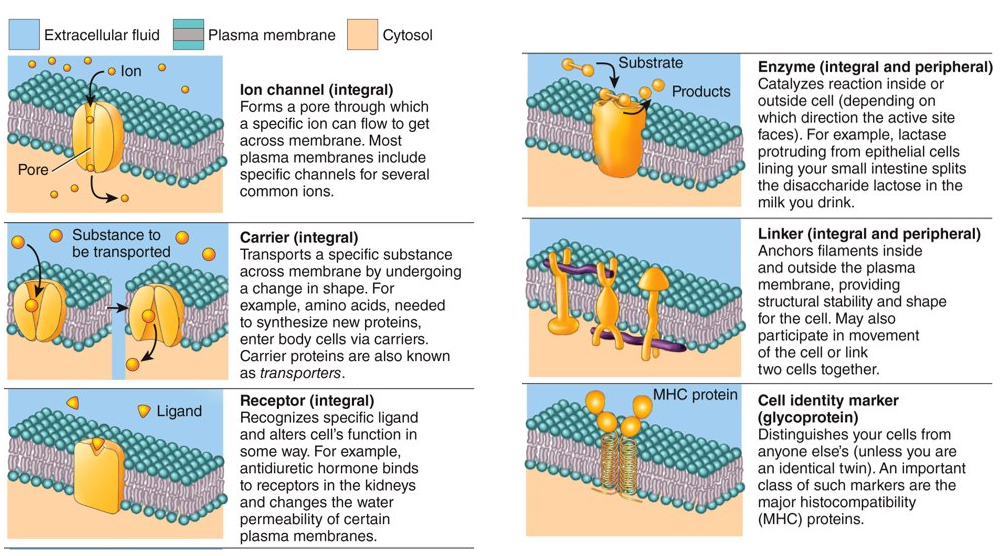
12
New cards
What role does cholesterol play in the membrane?
stabilization and reduction of membrane fluidity
13
New cards
What is the plasma membrane's permeability to small, nonpolar, uncharged molecules?
always permeable
14
New cards
What is the plasma membrane's permeability to water?
observed permeability due to aquaporin channels/proteins within the membrane that are selective for water molecules
15
New cards
What increase the permeability of the membrane?
transmembrane proteins
16
New cards
How do macromolecules pass through the membrane?
vesicular transport
17
New cards
What is a concentration gradient?
a difference in concentration of a chemical between one side and the other of the membrane
18
New cards
What is more concentrated on the outside of the membrane?
oxygen and sodium ions
19
New cards
What is more concentrated on the inside of the membrane?
carbon dioxide and potassium ions
20
New cards
What is the membrane potential?
when the inner surface of the membrane is more neg. charged and the outer surface is more pos. charged setting up a electrical gradient/membrane potential
21
New cards
What is the term for both the concentration and electrical gradients?
electrochemical gradient
22
New cards
What is a passive process?
a type of transportation driven by concentration gradients
23
New cards
What is an active process?
a type of transportation that requires energy (ATP)
24
New cards
What are the three types of passive processes?
simple diffusion, facilitated diffusion, and osmosis
25
New cards
What is diffusion?
movement of molecules or ions down a conc. gradient due to their kinetic energy until they reach equilibrium
26
New cards
What is simple diffusion and an example?
nonpolar, hydrophobic molecules and ammonia diffuse across the lipid bilayer without the help of transport proteins (gas exchange, nutrient absorption, excretion of some wastes)
27
New cards
What is facilitated diffusion?
Transmembrane proteins help solutes that are too polar or charged move through the lipid bilayer, will either be a carrier (glucose (and all family members) and some vitamins) or a channel (most are ion channels and some are gated: potassium)
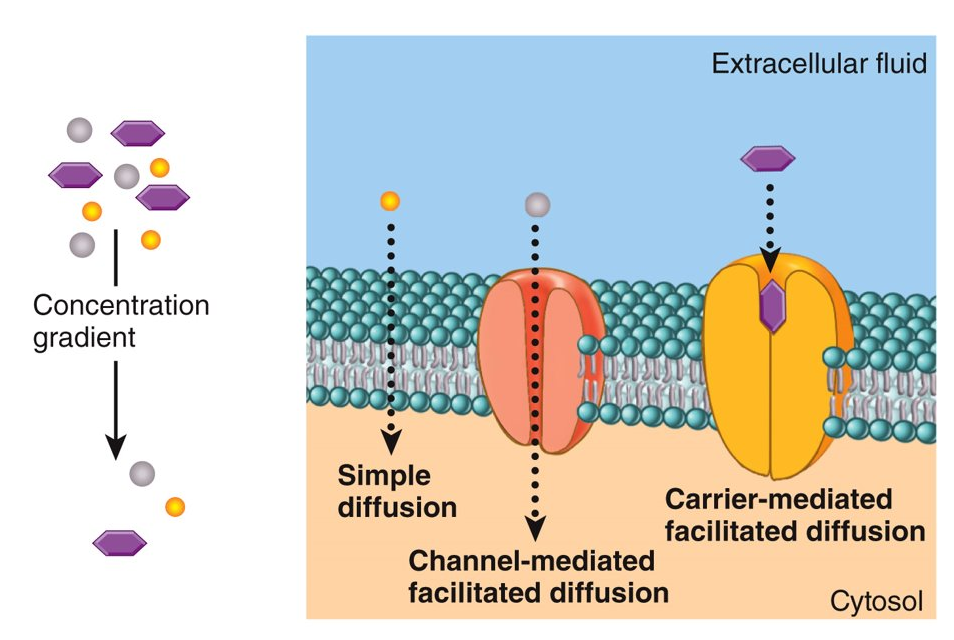
28
New cards
What is osmosis?
the movement of a solvent through a selectively permeable membrane from high to low conc. (only occurs when the membrane is permeable to water but not certain solutes)
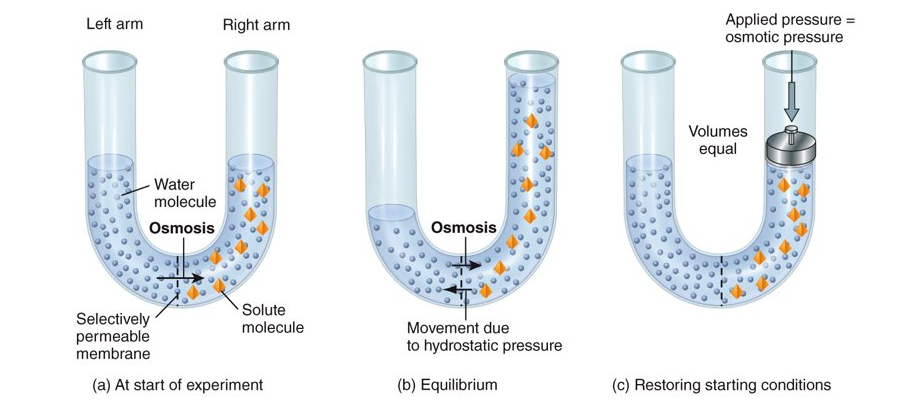
29
New cards
What can happen when water moves through the membrane?
generates hydrostatic pressure
30
New cards
What are the three tonicities and what do they mean?
isotonic (same conc. inside and outside the cell (ex. 0.9% NaCl)), hypotonic (conc. is higher inside cell than outside (ex. 3% NaCl)), and hypertonic (conc. is lower inside cell than outside (ex. 0.45% NaCl))

31
New cards
What are the three types of active processes?
primary, secondary, and vesicular transport
32
New cards
What is primary active transport and an example?
energy from ATP changes the shape of the transporter protein which pumps a substance against its conc. gradient (sodium ion/potassium ion pump)
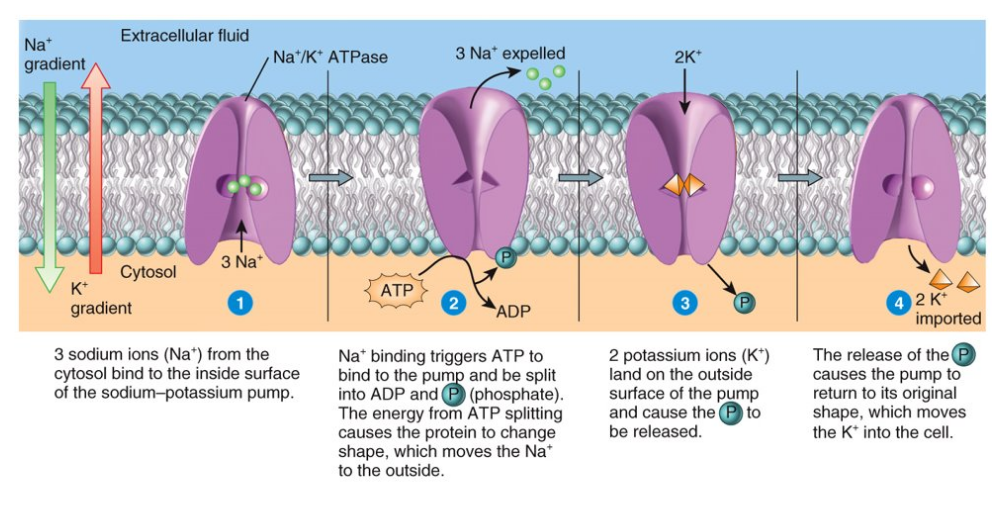
33
New cards
What is secondary active transport and an example?
energy is stored in a hydrogen or sodium conc. gradient and used to drive other substances against conc. gradients (antiporters and symporters)
34
New cards
What is the difference between an antiporter and a symporter?
an antiporter swaps places of two substances while a symporter allows substances to travel together
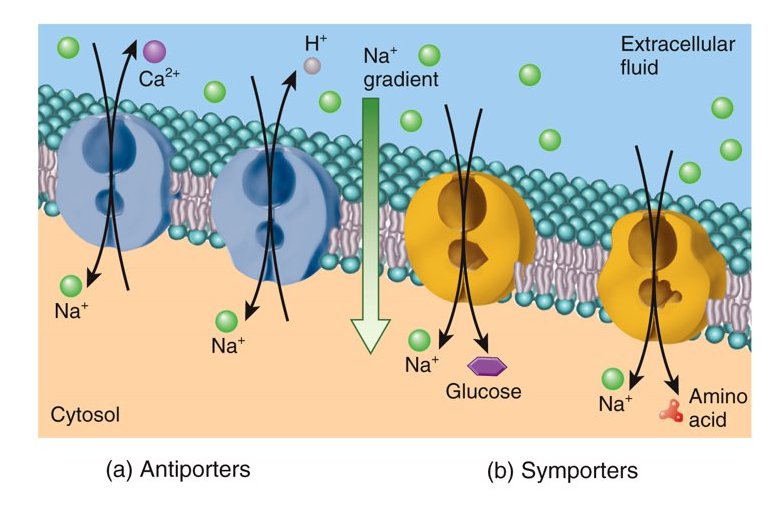
35
New cards
What is vesicular transport?
materials moving into, out of, or through a cell via a vesicle
36
New cards
What is endocytosis and its three forms?
the movement of materials into the cell (receptor-mediated, phagocytosis, and pinocytosis/bulk phase)
37
New cards
What is receptor-mediated endocytosis?
A large molecule binds to the cell, the receptor becomes triggered and tells the cell to take in the substance by forming a vesicle around it, the vesicle moves into the cell and it begins uncoating the vesicle, it fuses with endosome, the remaining receptors are recycled, and then the substance is degraded in lysosome (viruses take advantage of this)
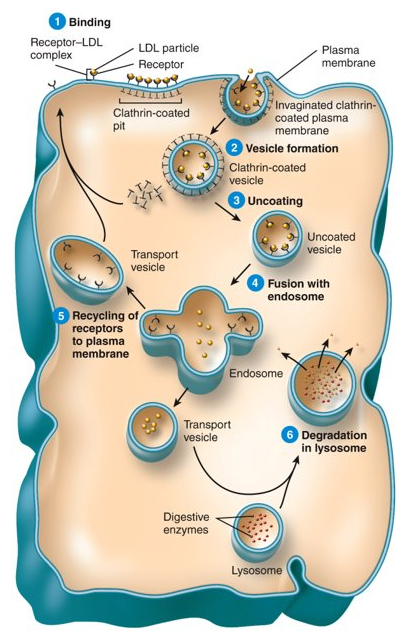
38
New cards
What is phagocytosis?
the ingestion of bacteria and other material by macrophages and neutrophils
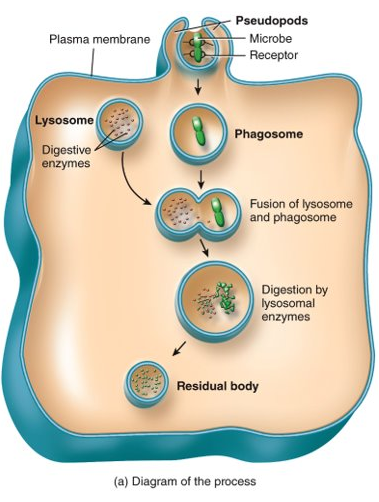
39
New cards
What is pinocytosis?
the ingestion of extracellular fluid
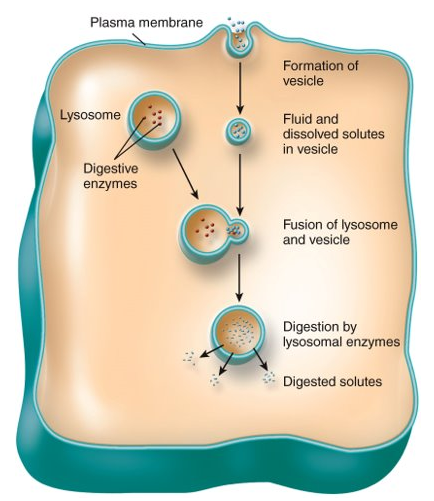
40
New cards
What is exocytosis?
secretory vesicles form inside the cell, bind with membrane, and release their contents
41
New cards
What is transcytosis?
both exo- and endocytosis, moving substance from one side of cell to the other
42
New cards
What makes up the cytoplasm?
cytosol and organelles
43
New cards
What is cytosol and its function?
water, solutes, particles, lipid droplets, and glycogen granules: metabolic reactions
44
New cards
What is the cytoskeleton and its function?
microfilaments (actin: movement), intermediate filaments (several proteins: support and anchoring), and microtubules (tubulin: determine cell shape, intracellular transport, and migration of chromosome in cell division)
45
New cards
What is centrosome and its function?
centrioles and pericentriolar matrix: growth of mitotic spindle and microtubule formation
46
New cards
What is cilia and its function?
short, hair-like projections: move materials across the surface of the cell (trachea)
47
New cards
What is the flagella and its function?
a tail-like projection: moves entire cell (only example sperm)
48
New cards
What is ribosome and its function?
ribosomal RNA and proteins: protein synthesis
49
New cards
What is the endoplasmic reticulum and its function?
membranous network of flattened sacs or tubules (cisterns): rough=ribosome, smooth=no ribosome): rough; synthesize glycoproteins and phospholipids, smooth; synthesize fatty acids and steroids, stores and releases calcium ions in muscle cells
50
New cards
What is the golgi complex and its function?
four-six stacked, membranous sacs (cisterns): process, sort, and deliver proteins and lipids to the plasma membrane, lysosomes, and secretory vesicles
51
New cards
What is lysosomes and its function?
membrane enclosed vesicle, contain digestive enzyme: intracellular digestion, autophagy, autolysis, embryological development, and extracellular digestion
52
New cards
What is peroxisomes and its function?
similar to lysosome, contain oxidases and catalase: oxidizes amino acids and fatty acids as well as detoxifies harmful substances like OH and other free radicals
53
New cards
What is proteasome and its function?
tiny barrel-shape that contains proteases: degrades useless proteins by cutting them into peptides
54
New cards
What is the mitochondrion and its function?
double-membrane, cristae, and matrix: site of ATP production by catabolism of nutrient molecules, helps in apoptosis, self-reproduce
55
New cards
What is the nucleus and its function?
nuclear envelope with pores, nucleoli, and chromosomes: pores (movement of substances in and out), nucleoli (produce ribosomes), and chromosomes (control cellular structure and direct cellular function)
56
New cards
What is transcription?
occurs in the nucleus and is the process of genetic info encoded in DNA being copied onto a strand of RNA to direct protein synthesis
57
New cards
What is translation?
occurs in the cytoplasm and is the process of reading the mRNA nucleotide sequence to determine the amino acid sequence of the protein
58
New cards
What are the two types of nuclear division?
mitosis and meiosis
59
New cards
What is the difference between mitosis and meiosis?
mitosis occurs during somatic cell division (when the nucleus divides, 2 sets of chromosome into 2 nuclei) and meiosis occurs during reproductive cell division (production of four haploid cells, one set of chromosome in each)
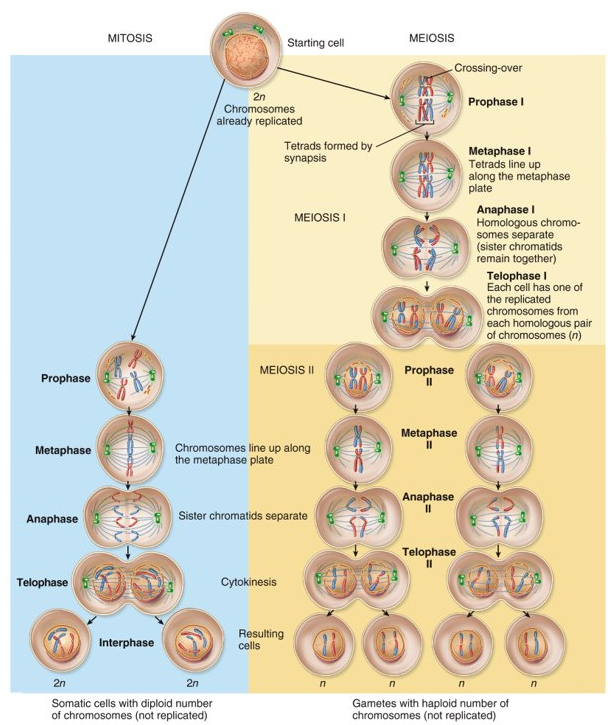
60
New cards
What is the cytoplasmic division and what does it do?
cytokinesis: a cleavage furrow forms and separates the cell
61
New cards
What are the 6 steps of the cell cycle?
interphase, prophase, metaphase, anaphase, telophase, and cytokinesis
62
New cards
What are the three destinies of a cell?
remain alive and functioning without dividing, grow and divide, and die
63
New cards
What is apoptosis?
cell death, which is triggered either outside or inside the cell due to a "cell-suicide" gene
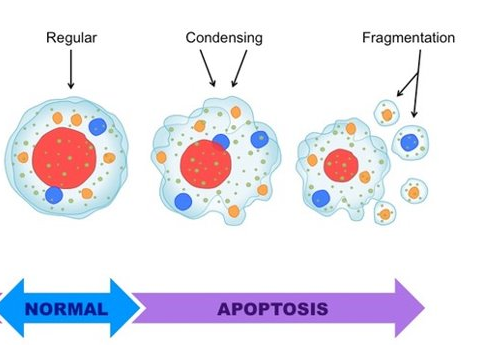
64
New cards
What is necrosis?
a pathological cell death due to injury
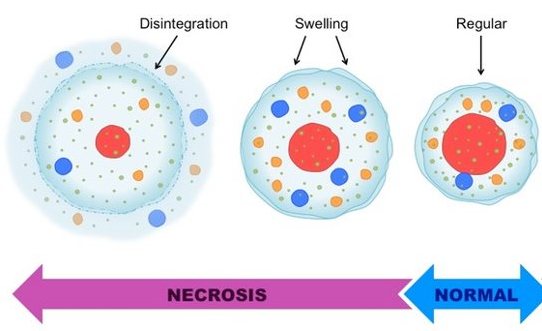
65
New cards
What happens to our cells as we age?
they gradually deteriorate in functional abilities, their ability to respond to stresses, less body cells, and lose integrity of extracellular components of our tissues
66
New cards
What is cancer?
a disease that has uncontrolled cell proliferation (divide without control) developing into a tumour or neoplasm
67
New cards
What is atrophy?
decrease in cell size

68
New cards
What is hypertrophy?
increase in cell size

69
New cards
What is hyperplasia?
increase in cell number

70
New cards
What is metaplasia?
reversible replacement of one mature cell type by another less mature cell type

71
New cards
What is dysplasia?
abnormal cellular growth; atypical hyperplasia
